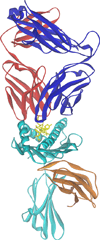Thermodynamics of T-cell receptor-peptide/MHC interactions: progress and opportunities
- PMID: 18496839
- PMCID: PMC3674762
- DOI: 10.1002/jmr.896
Thermodynamics of T-cell receptor-peptide/MHC interactions: progress and opportunities
Abstract
alphabeta T-cell receptors (TCRs) recognize peptide antigens presented by class I or class II major histocompatibility complex molecules (pMHC). Here we review the use of thermodynamic measurements in the study of TCR-pMHC interactions, with attention to the diversity in binding thermodynamics and how this is related to the variation in TCR-pMHC interfaces. We show that there is no enthalpic or entropic signature for TCR binding; rather, enthalpy and entropy changes vary in a compensatory manner that reflects a narrow free energy window for the interactions that have been characterized. Binding enthalpy and entropy changes do not correlate with structural features such as buried surface area or the number of hydrogen bonds within TCR-pMHC interfaces, possibly reflecting the myriad of contributors to binding thermodynamics, but likely also reflecting a reliance on van't Hoff over calorimetric measurements and the unaccounted influence of equilibria linked to binding. TCR-pMHC binding heat capacity changes likewise vary considerably. In some cases, the heat capacity changes are consistent with conformational differences between bound and free receptors, but there is little data indicating these conformational differences represent the need to organize disordered CDR loops. In this regard, we discuss how thermodynamics may provide additional insight into conformational changes occurring upon TCR binding. Finally, we highlight opportunities for the further use of thermodynamic measurements in the study of TCR-pMHC interactions, not only for understanding TCR binding in general, but also for understanding specifics of individual interactions and the engineering of TCRs with desired molecular recognition properties.
Figures


References
-
- Anikeeva N, Lebedeva T, Krogsgaard M, Tetin SY, Martinez-Hackert E, Kalams SA, Davis MM, Sykulev Y. Distinct Molecular Mechanisms Account for the Specificity of Two Different T-Cell Receptors. Biochemistry. 2003;42:4709–4716. - PubMed
-
- Baker BM, Murphy KP. Dissecting the energetics of a protein-protein interaction: the binding of ovomucoid third domain to elastase. J Mol Biol. 1997;268:557–569. - PubMed
-
- Baker BM, Murphy KP. Prediction of binding energetics from structure using empirical parameterization. Methods Enzymol. 1998;295:294–315. - PubMed
Publication types
MeSH terms
Substances
Grants and funding
LinkOut - more resources
Full Text Sources
Research Materials

